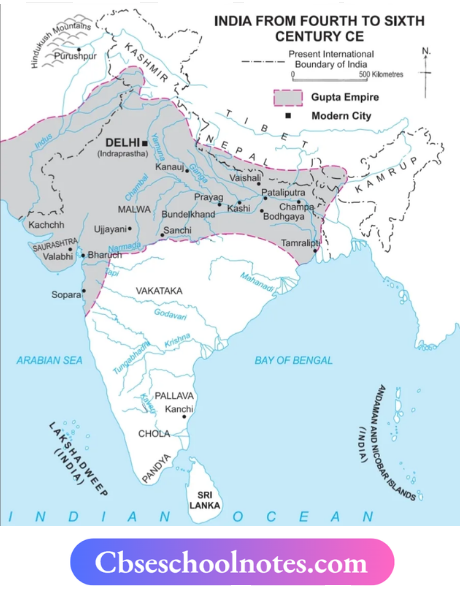CBSE Notes For Class 6 History Social Science Chapter 7 From A Kingdom To An Empire
The Mauryan Empire
- The Mauryan Empire was founded by Chandragupta Maurya more than 2300 years ago.
- Chandragupta Maurya was supported by a wise man named Chanakya or Kautilya. Many of Chanakya’s ideas were written down in a book called the Arthashastra.
- There were several cities in the Mauryan empire including the capital Pataliputra, Taxila and Ujjain. Taxila was a gateway to the North-West, including Central Asia, while Ujjain lay on the route from North to South India. Merchants, officials and craftspersons probably lived in these cities.
- In other areas, there were villages of farmers and herders. In some areas such as Central India, there were forests where people gathered forest produce and hunted animals for food.
- People in different parts of the empire spoke different languages, ate different kinds of food and wore different kinds of clothes.
Ruling the Mauryan Empire
- In the Mauryan Empire, the area around Pataliputra was under the direct control of the emperor. Officials were appointed to collect taxes from farmers, herders, craftspersons and traders, who lived in villages and towns in the area.
- Officials also punished those who disobeyed the ruler’s orders, and many of these officials were given salaries.
- Taxes were collected on a regular basis, whereas tribute was collected as and when it was possible. Tribute was collected in the form of a variety of things from the people who gave them more or less willingly.
- Messengers went from place to place, and spies kept a watch on the officials. The emperor supervised them all, with the help of members of the royal family and senior ministers.
- The other areas or provinces were ruled by a provincial capital such as Taxila or Ujjain. These provinces were controlled by Pataliputra to some extent, and mostly the royal princes were sent to these provinces as Governors. However, local customs and rules were probably followed in these provinces.
- Apart from these provinces, there were vast areas between the provincial centres. The Mauryas tried to control roads and rivers in these centres which were important for transport, and to collect resources as tax and tribute.
- According to Arthashastra, the North-West was important for blankets and South India for its gold and precious stones. It is possible that these resources were collected as tribute.
- There were also regions with forests where the people were more or less independent, However, they may have been accepted to provide elephants, timber, honey and wax to Maruyan Officials

Class 6 History Social Science Chapter 7 Ashoka, A Unique Ruler
- He was the most famous Mauryan ruler and was the first ruler who tried to spread his message to the people through inscriptions.
- Most of Ashoka’s inscriptions were in Prakrit and were written in the Brahmi script. His inscriptions were inscribed on pillars, as well as on rock surfaces.
- Ashoka fought a war to conquer Kalinga, the ancient name of coastal Orissa. However, he was horrified to see the violence and decided not to fight any more wars.
- He is the only king in the history of the world who gave up conquest after winning a war.
Class 6 History Social Science Chapter 7 Ashoka’s Dhamma
- Dhamma is the Prakrit word for the Sanskrit term ‘Dharma’ or ‘Duty’.
- Ashoka’s dhamma did not involve worship of a God, or performance of a sacrifice. He felt that he had a duty to instruct his subjects like a father tries to teach his children.
- He was also inspired by the teachings of the Buddha. There were a number of problems that worried Ashoka such as
- The people in the empire followed different religions and this sometimes led to conflict.
- H Slaves and servants were ill-treated, and there were fights in families and amongst neighbours.
- Ashoka felt that it was his duty to solve these problems. So, he appointed officials, known as the dhamma mahamatta who went from place to place teaching people about dhamma.
- He also sent messengers to spread ideas about dhamma to other lands, such as Syria, Egypt, Greece and Sri Lanka. Ashoka sent his son Mahendra and daughter Sanghmitra to Sri Lanka to spread the ideas of Dhamma.
- Ashoka got his messages inscribed on rocks and pillars and instructed his officials to read his message to those who could not read it themselves.
- He built roads, dug wells, rest houses, and made arrangements for medical treatment for both human beings and animals.
